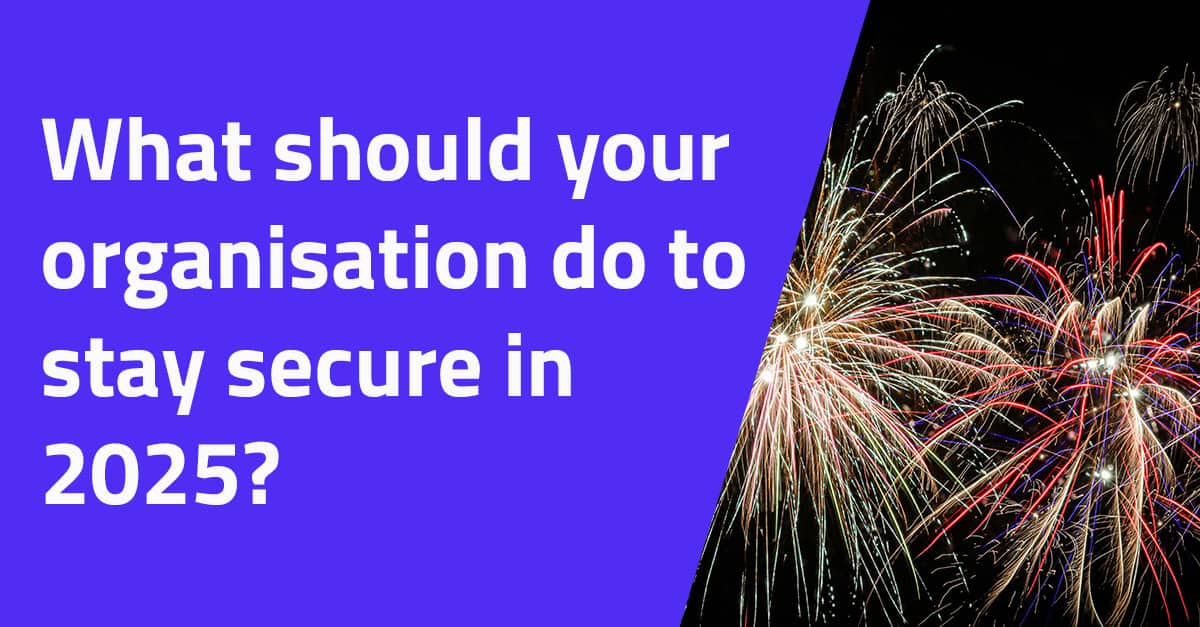
A new year is upon us and we hope that 2025 is your most prosperous and successful yet! However, as soon as the champagne corks had popped, the first cyber threats of the year were upon us and keeping secure should be a priority for any organisation.
With lots of threats facing organisations this year, it’s a matter of when, not if, your organisation will be affected, so we thought we’d put together some of the top trends we expect this year and what you should be strengthening your defences on…
Optimising Cloud Security
The shift to cloud services has increased security risks due to misconfigurations during implementation and shared responsibility models.
Improving trust in cloud environments is key as it safeguards sensitive customer and operational data.
What can organisations do?
- Invest in Cloud Security Posture Management (CSPM) to detect misconfigurations.
- Implement access controls like Role-Based Access Control (RBAC).
- Encrypt data in transit and at rest using strong encryption methods.
- Implement Information Rights Management (IRM) on documents stored in the cloud.
Zero-Trust Architecture
Zero Trust operates on the principle of “never trust, always verify.” It assumes that threats could exist both inside and outside the network perimeter.
Having a Zero-Trust architecture enhances security for hybrid workforces and prevents lateral movement of attackers within the network.
What can organisations do?
- Implement identity and access management (IAM) tools with multi-factor authentication (MFA) enabled on all accounts across all platforms where applicable.
- Use segmentation to isolate sensitive data and systems.
- Continuously monitor user behaviour and device trustworthiness, using a Service Operations Centre (SOC) or implementing a device management system like Microsoft Intune.
Remote and Hybrid Work
Working remotely which will continue to be the norm for lots of companies in 2025 (like us!) but it does expand the attack surface to include personal devices, home networks, and cloud-based collaboration tools.
Improving security in this area secures work from home setups and reduces risks stemming from personal device use.
What can organisations do?
- Implement Mobile Device Management to keep track of devices. We recommend Microsoft Intune.
- Use Virtual Private Networks (VPNs) or Zero Trust Network Access (ZTNA).
- Deploy Endpoint Detection and Response (EDR) solutions to monitor and secure devices.
- Conduct security awareness training for remote employees.
Ransomware
Ransomware attacks are becoming more sophisticated, involving data exfiltration and double extortion techniques.
Investing in preventing ransomware attacks mitigates financial and reputational losses by minimising the likelihood of them being successful.
What can organisations do?
- Regularly back up critical data and test recovery processes. Having a recovery plan is essential.
- Deploy anti-ransomware solutions and email filtering tools.
- Educate employees on recognising phishing attempts.
IoT Security for Business Ecosystems
The increasing use of IoT devices in businesses (smart HVAC systems, manufacturing sensors, etc.) creates new attack vectors.
Being aware of the security risk of these devices can expose you to, can help reduces risk of breaches through IoT devices and ensures uninterrupted business operations.
What can organisations do?
- Maintain a separate network for IoT devices (network segmentation).
- Regularly update IoT device firmware to address known vulnerabilities.
- Use device authentication protocols to ensure only authorised devices connect.
Cyber Essentials
Industry bodies are now enforcing stricter cybersecurity standards, making compliance essential and most in the UK are opting for the government-backed Cyber Essentials.
Having a Cyber Essentials certificate ensures an organisation is meeting a standard baseline of cyber security basics which can help prevent the majority of attacks.
What can organisations do?
- Contact a certification body to start their journey (we are a certification body and can help you achieve Cyber Essentials).
- Use this as a starting point for other security projects.
- Find out more on the Government website or our dedicated Cyber Essentials page
Employee Awareness and Training
Employees are often the weakest link in cybersecurity due to phishing and social engineering attacks.
Investing in training or an ongoing awareness platform (such as D2Aware) strengthens the human firewall and reduces risks of breaches caused by human error.
What can organisations do?
- Conduct simulated phishing exercises to test awareness.
- Provide role-specific cybersecurity training for high-risk employees.
- Establish clear reporting protocols for suspected threats.
2025 is expected to break records for the amount of attacks globally and organisations need to be prepared.
As a Cyber Security company, we are on hand to discuss the bespoke security requirements of any organisation. If you aren’t sure where to turn, or need assistance securing your organisation, contact our team today.